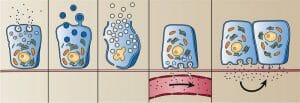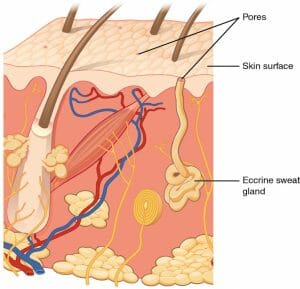Gland Definition
A gland is a group of cells or a “secreting organ” that excretes a chemical substance. This substance can take the form of hormones, sweat, saliva, mucus, or acids (i.e. HCl acid in gastric glands). Glands are tasked with helping create the substance that they then secrete for further use or total elimination from the body.

The image shows the different ways that cells secrete substances
Now, let’s discuss the actual development of a gland. Each gland can be thought of as an ingrowth of the top layer of skin called the epithelium. It is the surface-most layer of our skin. This ingrowth is notably tubular and could start off as a column of cells or as a tubular pre-structure. With time, the column of cells divides or gives rise to branches that help form compound glands. This branching is particularly useful in the creation of large and heavily branched glands like the salivary and pancreatic glands in the body that contain an impressive surface area. These formations (simple, branched and compound) make up a variety of glandular structures.
However, shape is the ultimate determinant of the gland’s classification. If the gland maintains a tubular shape during growth, then it is called a tubular gland. If the secretory part of the gland swells in size, then it is called an alveolar gland (taking on a “bulb-like” shape much like the one in our lung’s alveolar sacs). Coiled glands curl around and acinar cells have a lobed berry look. Glands organized in a simple, non or minimally-branched form include the variations listed in the figure below.

The image depicts five types of simple glands (in order): simple tubular, simple branched tubular, simple coiled tubular, simple acinar, and simple branched acinar glands.
Similarly, compound glands come in three main forms. The main difference between compound glands and simple glands is that they come in more complicated, branched arrangements. They take on tubular, acinar, or a combined tubule-acinar shape, as shown below.

The image depicts three compound glands: compound tubular, compound acinar, and compound tubule-acinar glands.
Types of Gland
Glands are sectioned into two groups on the basis of their function. Endocrine glands excrete chemicals, such as hormones, through the basal lamina of cells that travel through the blood stream. Examples of endocrine glands are the thyroid glands and pituitary glands which play important roles in preserving the homeostatic balance of the body. But endocrine glands are varied.
Major endocrine glands (and their main functions):
- Thyroid gland: mainly helps to regulate our metabolism and vital bodily functions with the release of TSH, T3, and T4 hormones. This gland is butterfly-shaped and located in the neck. Other functions it helps regulate are our breathing, our hear rate, our weight and our body temperature (and so much more).
- Pituitary gland: is the size of a pea and is located behind our noses. It is directly controlled by the hypothalamus. The pituitary gland is often called the “master gland” because it releases a plethora of growth and stimulatory hormones that affect our thyroid, adrenal glands, and sex organs (i.e. prolactin which stimulates milk production, growth hormones for muscle and bone mass, etc.)
- Pancreas: is also considered a gland despite being an entire organ as it is a secretory organ. It maintains healthy blood sugar levels via insulin and glucagon release. The pancreas also releases digestive enzymes that break down protein, fats, and carbs in our food.
- Pineal gland: releases melatonin, which is involved in the sleep cycle. The pineal gland has a role in regulating our circadian rhythm (or waking-sleeping cycles that are linked to the periods of lightness and darkness over the 24-hour cycle).
- Adrenal gland: help control blood sugar and use of carbs and fats. They are located on top of each kidney, and release sex hormones and cortisol – which is a stress hormone.
- Thymus: is located between our lungs and is only active until puberty commences. It secretes hormones important for puberty and a healthy immune system.
- Testes (in males): release the sex hormone testosterone. Despite lying freely in the scrotum, it is connected to the body by the spermatic cord, which is highly innervated and connected to our blood vessels. Testosterone promote sperm production & our sex drive.
- Ovaries (in females): produces estrogen, which promotes breast development & healthy periods. Estrogen initiates menstruation, and the release of an egg each month.
Exocrine glands, on the other hand, use ducts to expel their material onto an epithelial surface rather than the bloodstream. This external surface can be our skin or even our GI tract. The material is always expelled onto the apical (“top”) surface of our cells.
Major exocrine glands:
- Salivary glands (contains amylase to help soften our food)
- Bile-making glands of liver
- Part of the pancreas that secretes pancreatic enzymes into the duodenum of the small intestine
- Prostate gland (helps propel seminal fluid during ejaculation)
- Gastric glands (digests our food)
- Sweat glands (removes heat from the body)
Everyday Examples of Glands
A gland that we are all, perhaps, painfully aware of is the sweat gland. Whether we sense them during a class speech or after a nice hour of exercise, we know that our sweat glands are close to the epidermis of the skin and secrete beads of moisture. There are two types of sweat glands: eccrine and apocrine. Eccrine glands are distributed throughout our bodies and secrete water-based moisture; it is our body’s main way of cooling itself. Apocrine glands, on the other hand, are those located in our armpits and perineal areas. Apocrine glands are known to pinch their secretions off into vesicles that then enter the lumen. While they play a less significant role in humans, they are the sole glands in hoofed animals like cattle.

Depicted in the figure is an eccrine sweat gland.
Another familiar apocrine gland in mammals are mammary glands. Mammary glands can be classified as exocrine (rather than endocrine), and are used to store and secrete milk to feed young animals. As apocrine glands do, lactating animals are able to pinch off their milk secretions in membrane-bound vesicles.
Quiz
1. What is the main determinant of how a gland is classified?
A. Material excreted
B. Cell quantity
C. Shape
D. Location
2. Define the distinction between endocrine and exocrine glands:
A. Endocrine glands secrete from apical lamina into the bloodstream; exocrine glands to basal surface of epithelium
B. Endocrine glands secrete from basal lamina into the bloodstream, exocrine glands to apical surface of epithelium
C. Exocrine glands secrete from the apical lamina into the bloodstream, endocrine glands to basal surface of epithelium
D. Exocrine glands secrete material through membrane-bound vesicles, endocrine glands do not.
3. Which of the following is characteristic of the apocrine method of secretion?
A. Apocrine glands use vesicles to secrete contents
B. Apocrine glands release water-based moisture in beads to cool off the body
C. Apocrine glands use cell-signaling mechanisms exclusively to coordinate secretion
D. Unlike eccrine glands, apocrine glands are more populous and dispersed throughout the body
References
- Hormone Health Network (2017). “Endocrine Glands and Types of Hormones.” Hormone.org. Retrieved on 2017-05-28 from http://www.hormone.org/hormones-and-health/endocrine-glands-and-types-of-hormones
- Ingraham, Susan (2016). “The Exocrine System: How it Works.” Exocrine-System Retrieved on 2017-05-28 from http://www.susaningraham.net/exocrine-system.html
- Prakash Mohini (2017). “What is the difference between Simple Gland and Compound Gland?” Preserve articles. Retrieved on 2017-05-29 from http://www.preservearticles.com/2011082111261/what-is-the-difference-between-simple-gland-and-compound-gland.html
- Theodora (2017). “Epithelial, endothelial and glandular tissue.” Theodora Encyclopedia. Retrieved on 2017-05-30 from http://www.theodora.com/encyclopedia/e/epithelial_endothelial_and_glandular_tissues.html
Gland
No comments:
Post a Comment